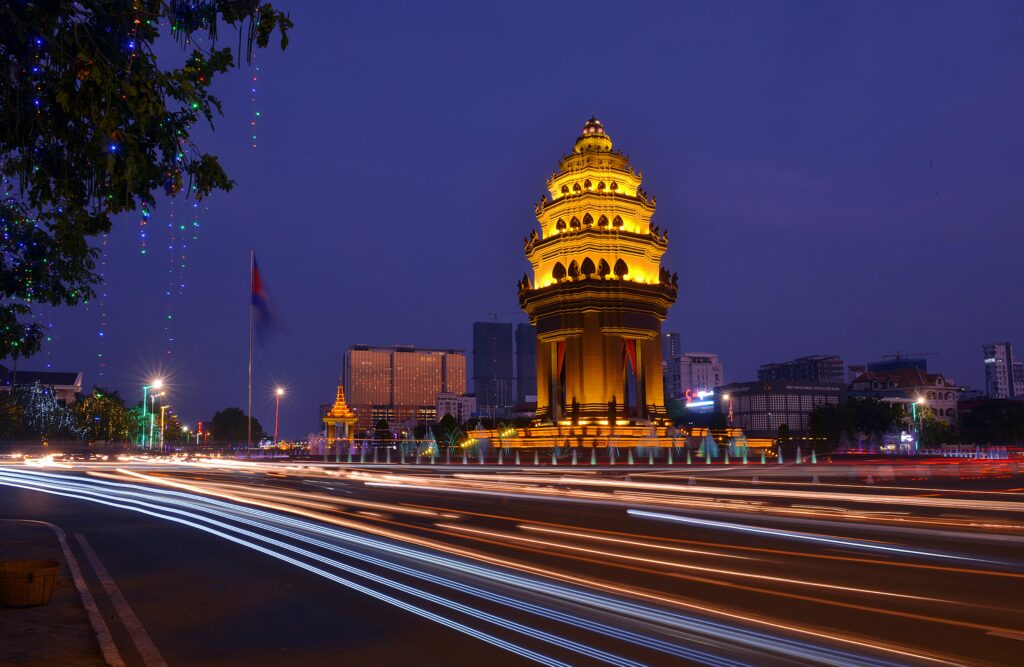Cambodia
Cambodia, located in Southeast Asia, is a country rich in history, culture, and natural beauty. Known for its ancient temples, vibrant traditions, and warm hospitality, Cambodia offers a diverse range of experiences for travelers.
Cambodia’s transportation network includes buses, tuk-tuks, and motorbikes. In cities like Phnom Penh and Siem Reap, tuk-tuks are a popular and convenient way to get around. For longer distances, buses and domestic flights connect major cities and tourist destinations.
Cambodian cuisine is known for its unique flavors and ingredients. Popular dishes include Amok (a creamy coconut curry), Khmer BBQ, and Lok Lak (stir-fried beef). Street food and local markets provide a range of authentic and affordable culinary experiences.

Key Highlights
- Angkor Wat: The most famous and largest religious monument in the world, Angkor Wat is an architectural marvel and a UNESCO World Heritage Site. It is the centerpiece of the Angkor Archaeological Park, which includes other significant temples like Bayon, Ta Prohm, and Angkor Thom.
- Phnom Penh: The capital city of Cambodia is a hub of historical and cultural landmarks. Key attractions include the Royal Palace, Silver Pagoda, and the National Museum. The Killing Fields and Tuol Sleng Genocide Museum offer poignant insights into Cambodia’s tragic recent history.
- Siem Reap: Aside from being the gateway to Angkor Wat, Siem Reap is known for its vibrant night markets, lively Pub Street, and traditional Apsara dance performances. The town offers a mix of cultural experiences and modern amenities.
- Kampot and Kep: Known for their scenic beauty, Kampot is renowned for its pepper plantations and tranquil riverside setting, while Kep is famous for its crab dishes and relaxed coastal atmosphere. Both towns offer a glimpse into Cambodia’s rural charm and natural landscapes.
- Sihanoukville: This coastal city is known for its beaches and island getaways. Nearby islands like Koh Rong and Koh Rong Samloem offer stunning white-sand beaches, clear waters, and opportunities for snorkeling, diving, and relaxation.
- Battambang: A charming city known for its colonial architecture, traditional Cambodian arts, and rural surroundings. The Bamboo Train is a unique and popular attraction for visitors.
Itinerary
Day 1: Arrival in Phnom Penh
- Morning: Arrive at Phnom Penh International Airport and transfer to your hotel. After checking in, take some time to rest or explore the area around your hotel.
- Afternoon: Start your exploration with key landmarks in Phnom Penh.
- Royal Palace and Silver Pagoda: Visit the Royal Palace complex, including the Silver Pagoda, known for its stunning collection of Buddha statues and silver-tiled floor.
- National Museum: Explore the museum’s impressive collection of Khmer artifacts and sculptures.
- Evening: Enjoy dinner at a riverside restaurant along the Tonle Sap River. Try local Khmer dishes such as amok (a coconut curry) or lok lak (stir-fried beef).
Day 2: Phnom Penh – Historical Sites
- Morning: Visit the Tuol Sleng Genocide Museum and Killing Fields.
- Tuol Sleng Genocide Museum: Learn about the tragic history of the Khmer Rouge era at this former prison.
- Choeung Ek Killing Fields: Take a short drive to the Killing Fields memorial to learn about the atrocities committed during the Khmer Rouge regime.
- Afternoon: Explore Phnom Penh’s markets.
- Central Market (Phsar Thmey): Browse through this iconic Art Deco market for souvenirs, jewelry, and local products.
- Russian Market (Phsar Toul Tom Poung): Explore this bustling market known for its variety of crafts, textiles, and antiques.
- Evening: Enjoy a relaxing dinner and a drink at one of Phnom Penh’s rooftop bars or local restaurants.
Day 3: Travel to Siem Reap
- Morning: Take a flight or bus to Siem Reap, the gateway to the Angkor temples. Transfer to your hotel upon arrival.
- Afternoon: Begin exploring the Angkor complex.
- Angkor Wat: Visit this iconic temple, known for its grandeur and intricate carvings. Spend several hours exploring the temple and its surrounding galleries.
- Evening: Enjoy dinner at a local restaurant in Siem Reap. Try traditional Cambodian dishes such as Khmer curry or grilled fish.
Day 4: Angkor Temples
- Morning: Continue exploring the Angkor Archaeological Park.
- Bayon Temple: Explore the enigmatic temple with its large stone faces and detailed bas-reliefs.
- Ta Prohm: Visit this temple known for the trees growing over its ruins, made famous by the film “Tomb Raider.”
- Afternoon: Visit additional temples and landmarks.
- Angkor Thom: Explore the ancient walled city and its various temples, including the Baphuon and Phimeanakas.
- Preah Khan: Visit this sprawling temple complex, known for its impressive size and historical significance.
- Evening: Experience the vibrant night market in Siem Reap, where you can shop for handicrafts and enjoy local street food.
Day 5: Floating Villages and Culture
- Morning: Visit a floating village on Tonle Sap Lake.
- Kompong Phluk or Chong Kneas: Take a boat tour to see the unique floating homes and daily life of the residents. Experience the tranquil beauty of the lake and its surroundings.
- Afternoon: Visit a local village or cultural center.
- Cambodian Cultural Village: Learn about traditional Cambodian culture through exhibits and performances.
- Evening: Enjoy a traditional Apsara dance performance with dinner. Many restaurants in Siem Reap offer this cultural experience.
Day 6: Travel to Battambang
- Morning: Travel to Battambang by bus or private transfer.
- Afternoon: Explore Battambang’s attractions.
- Bamboo Train: Ride the unique bamboo train through the countryside and enjoy the scenic views.
- Battambang’s Colonial Architecture: Walk through the city center and admire its well-preserved French colonial buildings.
- Evening: Enjoy dinner at a local restaurant in Battambang and explore the evening market.
Day 7: Return to Phnom Penh and Departure
- Morning: Travel back to Phnom Penh.
- Afternoon: Depending on your departure time, you may have some last-minute shopping or sightseeing.
- Wat Phnom: Visit this hilltop temple, a prominent landmark in Phnom Penh.
- Shopping: Explore local markets or boutique shops for souvenirs.
- Evening: Transfer to Phnom Penh International Airport for your departure.
Recommendations and Insights
- Transportation: In Phnom Penh and Siem Reap, tuk-tuks are a popular and convenient way to get around. For longer distances, consider taking flights or private transfers. In Battambang, renting a bicycle or scooter is a good option for exploring the area.
- Language: Khmer is the official language, but English is widely spoken in tourist areas. Learning a few basic Khmer phrases can be helpful and appreciated.
- Etiquette: Dress modestly when visiting temples and remove your shoes before entering temple buildings. It’s also polite to greet people with a smile and a slight bow, especially in more rural areas.
- Safety: Cambodia is generally safe for tourists, but be cautious of your belongings, especially in crowded areas. Be aware of local customs and follow health and safety guidelines.
- Seasonal Considerations: Cambodia has a tropical climate with a wet season (May to October) and a dry season (November to April). The best time to visit is during the dry season when the weather is more comfortable for sightseeing and outdoor activities.

